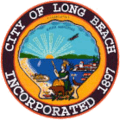Long Beach Airport
| Long Beach Airport | |||||||||||||||||||||||||||||||
|---|---|---|---|---|---|---|---|---|---|---|---|---|---|---|---|---|---|---|---|---|---|---|---|---|---|---|---|---|---|---|---|
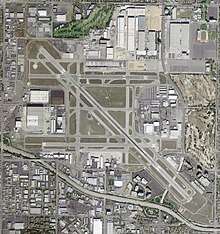 USGS aerial image, March 2004 | |||||||||||||||||||||||||||||||
| Summary | |||||||||||||||||||||||||||||||
| Airport type | Public | ||||||||||||||||||||||||||||||
| Owner | City of Long Beach | ||||||||||||||||||||||||||||||
| Serves | Los Angeles and Orange counties | ||||||||||||||||||||||||||||||
| Location | Long Beach, California | ||||||||||||||||||||||||||||||
| Focus city for | JetBlue Airways | ||||||||||||||||||||||||||||||
| Elevation AMSL | 60 ft / 18 m | ||||||||||||||||||||||||||||||
| Coordinates | 33°49′04″N 118°09′06″W / 33.81778°N 118.15167°WCoordinates: 33°49′04″N 118°09′06″W / 33.81778°N 118.15167°W | ||||||||||||||||||||||||||||||
| Website | www.LGB.org | ||||||||||||||||||||||||||||||
| Map | |||||||||||||||||||||||||||||||
 LGB Location of airport in Long Beach  LGB LGB (California)  LGB LGB (the US) | |||||||||||||||||||||||||||||||
| Runways | |||||||||||||||||||||||||||||||
| |||||||||||||||||||||||||||||||
| Helipads | |||||||||||||||||||||||||||||||
| |||||||||||||||||||||||||||||||
| Statistics (2017) | |||||||||||||||||||||||||||||||
| |||||||||||||||||||||||||||||||
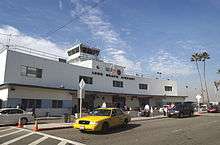
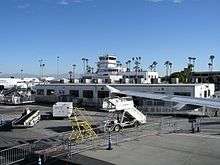
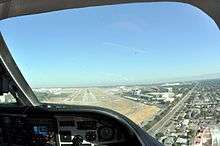
Long Beach Airport (IATA: LGB, ICAO: KLGB, FAA LID: LGB) is a city-owned public airport three miles northeast of downtown Long Beach, in Los Angeles County, California.[1] It was formerly called Daugherty Field.
This airport is included in the National Plan of Integrated Airport Systems for 2011–2015, which categorized it as a primary commercial service airport.[3] Federal Aviation Administration records say the airport had 1,413,251 passenger boardings in calendar year 2008,[4] 1,401,903 in 2009 and 1,451,404 in 2010.[5]
Overview
Located near the Los Angeles County and Orange County borders, Long Beach Airport serves the Los Angeles MSA. The airport operates commercial passenger, cargo, military, and general aviation activities. The airport is under one of the strictest ordinances in the United States on airport noise which set limits on the amount of noise the airport activities are allowed to create.[6]
It is the 10th busiest airport in California based on passenger boardings at 1.4 million. As of May 2018, JetBlue operates the most commercial flights out of Long Beach as one of its focus cities. The other airlines with operations at Long Beach are American, Delta, Hawaiian, and Southwest. Air cargo carriers, including FedEx and UPS, also use LGB. 57,000 tons of goods are carried each year.
The Boeing Company (formerly McDonnell Douglas) maintains maintenance facilities for Boeing and McDonnell Douglas/Douglas aircraft (including the historic DC-9 and DC-10 aircraft) at Long Beach, and produced the C-17 through 2015. Gulfstream Aerospace operates a completion/service center.
Commercial flights are restricted, but there are still many charters, private aviation, flight schools, law enforcement flights, helicopters, advertising blimps, planes towing advertising banners, etc. Long Beach airport is one of the busiest general aviation airports in the world, with 398,433 aircraft movements in 2007.[7]
The Long Beach Airport has an aggressive noise abatement program which includes three full-time noise specialists.[8] Under Long Beach municipal law, the city can criminally prosecute the aircraft's owner and the pilots for breaking the noise ordinance. As the airport continues to grow and air traffic over the region increases, so do the complaints about loud and low flying aircraft. The airport produces a monthly noise and complaint report.[9]
Long Beach Airport has one terminal in Streamline Moderne style that is a historical landmark and was renovated in early 2013.
Long Beach Transit Routes 102, 104, 111, and 176 serve the airport. Wardlow Road runs from the airport to the Los Angeles County/Orange County border, where it becomes Ball Road and crosses the north edge of the Disneyland Resort; Long Beach Airport is the second closest airport to Disneyland, after John Wayne Airport.
History
The first transcontinental flight, a biplane flown by Calbraith Perry Rodgers, landed in 1911 on Long Beach's sandy beach. From 1911 until the airport was created, planes used the beach as a runway.
The famous barnstormer Earl S. Daugherty had leased the area that later became the airport for air shows, stunt flying, wing walking and passenger rides. Later, he started the world's first flight school in 1919 at the same location. In 1923 Daugherty convinced the city council to use the site to create the first municipal airport.
Douglas "Wrong Way" Corrigan used to fly regularly out of Daugherty Field. Before his infamous flight from Brooklyn, New York, to Ireland in 1938, he had flown from Long Beach to New York. After authorities refused his request to continue on to Ireland, he was supposed to return to Daugherty Field, but a claimed navigational error routed him to Ireland. He never publicly acknowledged having flown there intentionally.
During the 1940s and 1950s the only airline nonstops from Long Beach Airport were to Los Angeles, San Diego, and sometimes Catalina Island; in 1962 Western Airlines introduced a daily Electra to San Francisco and one a day to San Diego. Jet schedules began in 1968; in 1969 Western Boeing 737-200s flew to Las Vegas, Oakland, and San Francisco. In 1980 the only jets were operated by Pacific Southwest Airlines (PSA) to SFO.
In 1981 a new airline based in Long Beach, Jet America, began nonstop MD-80s to Chicago and, in 1982, to Dallas-Fort Worth. That year Alaska Airlines began nonstop Boeing 727s to Portland and Seattle. In 1983 American Airlines introduced nonstops to Chicago O'Hare and Dallas-Fort Worth, and United Airlines began nonstops to Denver. Continental Airlines started nonstops to Denver as well. In 1984 United scheduled two Boeing 767-200s a day nonstop to Denver, the largest passenger airliners ever to serve LGB.
Between 1990 and 1992 Continental, Delta, TWA, and USAir ended service to LGB, as did American Airlines in early 2006.[10] Alaska Airlines later ended mainline service, and ended codeshared service in 2015. Delta Connection and American Eagle regional jet flights continue at LGB. In February 2016, Southwest Airlines announced plans to begin service to the airport with an initial 4 available slots.
Military use
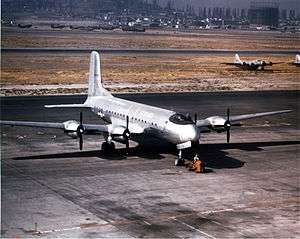
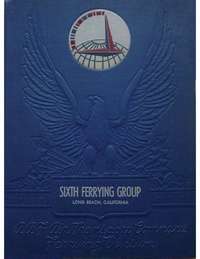
To attract the United States Navy, the City of Long Beach built a hangar and an administrative building and then offered to lease it to the Navy for $1 a year for the establishment of the Naval Reserve Air Base. On May 10, 1928, the U.S. Navy commissioned the field as a Naval Reserve Air Base (NRAB Long Beach). Two years later the city built a hangar and administrative building for the United States Army Air Corps as well. Significant developments to the little city airport began only after the city built hangars and administrative facilities for the Army and Navy in 1928-30.
As a Naval Reserve Air Base, the mission was to instruct, train and drill Naval Reserve aviation personnel. A ground school was offered three nights a week at the base and two nights a week at the University of California in Los Angeles until 1930, when ground school was continuously offered at the base. On April 9, 1939, training in night flight began, and shortly thereafter its facilities began to be used by fleet aircraft as well.
With increased activity by commercial airlines and the private airplane industry, particularly with Douglas Aircraft showing an interest in the Long Beach Municipal Airport, the facility needed more space. With Douglas Aircraft as a resident, the attitude of Long Beach's authorities became openly hostile to naval aviation, with its city manager saying that "the sooner the Navy gets out of the Long Beach airport, the better we will like it."
So the Navy had begun a survey for another site — unknown to city officials at the time. Admiral Ernest J. King, then the Chief of the Bureau of Aeronautics, and Admirals William D. Leahy, Joseph K. Taussig, and Allen E. Smith pointedly requested that the city of Long Beach repair the runways and reminded the city that the Pacific Fleet, then laying offshore in Long Beach and San Pedro harbors, had a payroll of more than $1 million a month. Eventually the city complied with the Navy's requests.
The city continued to show a hostile attitude toward approving a lease on any additional land that the Naval Reserve now required.
The Navy there upon, fed up with the city of Long Beach, decided upon the purchase of some property owned by a Mrs. Susanna Bixby Bryant, a fact made known by the commander of the base, Commander Thomas A. Gray, to the Chief of the Bureau of Aeronautics, Admiral John H. Towers. The circumstances behind the purchase were revealed to James V. Forrestal, Under Secretary of the Navy, and by him to the House Naval Affairs committee who approved the purchase. Although Comdr. Gray had offered Mrs. Bryant $350 an acre, in the best patriotic spirit she sold the property at $300 an acre.
With the site acquired, in 1941, construction funds soon followed and NAS Los Alamitos began to take shape. Upon the transfer of the Naval Reserve Training Facility to Los Alamitos, to the surprise of city officials of Long Beach, in 1942, instead of returning the Naval Reserve Air Base facilities at Long Beach to the city, the Navy turned over the facilities to the United States Army Air Forces, which had established a training base next to it. NARB Long Beach was not totally abandoned but became a Naval Auxiliary Air Station (NAAS).
The 1940s was a busy time. Through World War II the airfield was given over to the war effort. In August, 1941, the Civil Aeronautics Administration took over control of the airport, which had increased to 500 acres (2.0 km2). Once Los Alamitos became an operational base in 1941, NAAS Long Beach now turned to servicing carrier borne F4Fs, SBDs, FM-2s, F4Us, F6Fs, TBF/TBMs, and SB2Cs. In addition, it had utility aircraft and such patrol planes as the PBY, SNB, GB3, NH, GH, and SNJ.
As the Navy's activities began to be shifted to Los Alamitos the Long Beach Army Airfield at Long Beach became the home of the Army's Air Transport Command's Ferrying Division, with the 1736th Ferrying Squadron assigned,[11] which included a squadron of 18 women pilots commanded by Barbara London, a long time Long Beach aviator.
Like the Naval Air Ferry Command at NAS Terminal Island, the Army's ferrying work was an immense undertaking, thanks to Douglas Aircraft's wartime production. Ground was broken for the initial Douglas Aircraft facility in November 1940, with dedication in October 1941. Douglas had been drawn to Long Beach's growing municipal airport with its Army and Navy facilities. With wartime contracts the company went into intensive production. The company's first C-47 was delivered 16 days after the attack of Pearl Harbor and another 4,238 were produced during the war. The plant turned out some 1,000 A-20 Havocs, not to mention 3,000 B-17 Flying Fortresses and 1,156 A-26 Invaders.
With the end of the war the U.S. Navy abandoned any use of Long Beach Municipal Airport and with it the designation of Long Beach as a Naval Auxiliary Air Station.
Facilities and aircraft
Long Beach Airport covers an area of 1,166 acres (472 ha) at an elevation of 60 feet (18 m) above mean sea level. It has three asphalt-paved runways:[1]
- 12/30 is 10,000 by 200 feet (3,048 x 61 m)
- 7L/25R is 6,191 by 150 feet (1,887 x 46 m)
- 7R/25L is 5,423 by 150 feet (1,653 x 46 m)
It also has six helipads:
- H1 is 20 by 20 feet (6 x 6 m)
- H2 is 20 by 20 feet (6 x 6 m)
- H3 is 300 by 35 feet (91 x 11 m)
- H4 is 20 by 20 feet (6 x 6 m)
- H5 is 20 by 20 feet (6 x 6 m)
- H6 is 20 by 20 feet (6 x 6 m)
Runway 16L/34R and runway 16R/34L were permanently closed on July 21, 2016. Runway 16L/34R was 3,330 by 75 feet (1,015 x 23 m), and runway 16R/34L was 4,470 by 75 feet (1,362 x 23 m). Both runways will be removed.[12]
In the year ending December 1, 2010 the airport had 329,808 aircraft operations, an average of 903 per day: 87% general aviation, 10% scheduled commercial, 3% air taxi, and <1% military. At that time there were 435 aircraft based at this airport: 69% single-engine, 11% multi-engine, 11% jet, and 10% helicopter.[1]
Airlines and destinations
The gates at Long Beach Airport are divided into the North and South Concourses, with eleven gates in all. JetBlue Airways and Hawaiian Airlines occupy the North Concourse, the larger of the two. Delta Airlines, American Airlines, and Southwest Airlines occupy the South Concourse. Gates 1-4 are in the South Concourse and gates 5-11 in the North.
Passenger
| Airlines | Destinations | Refs |
|---|---|---|
| American Eagle | Phoenix–Sky Harbor | [13] |
| Delta Connection | Salt Lake City | [14] |
| Hawaiian Airlines | Honolulu | [15] |
| JetBlue Airways | Austin, Boston, Fort Lauderdale, Las Vegas, New York–JFK, Oakland, Portland (OR), Reno/Tahoe, Sacramento, Salt Lake City, San Francisco, San Jose (CA), Seattle/Tacoma Seasonal: Bozeman (begins December 13, 2018),[16] Hayden/Steamboat Springs (begins December 15, 2018)[16] | [17] |
| Southwest Airlines | Denver, Las Vegas, Oakland, Sacramento | [18] |
| Destinations map (Excludes Hawaii) |
|---|
 Long Beach Destinations from Long Beach Airport (Red) = Year-round Destination (Blue) = Future Destination |
Cargo
| Airlines | Destinations |
|---|---|
| FedEx Express | Memphis |
| UPS Airlines | Fort Worth/Alliance, Louisville |
Statistics
Top destinations
| Rank | City | Passengers | Airlines |
|---|---|---|---|
| 1 | Las Vegas, Nevada | 297,470 | JetBlue, Southwest |
| 2 | Oakland, California | 295,430 | JetBlue, Southwest |
| 3 | Salt Lake City, Utah | 271,290 | Delta, JetBlue |
| 4 | San Francisco, California | 193,020 | JetBlue |
| 5 | Sacramento, California | 167,710 | JetBlue, Southwest |
| 6 | San Jose, California | 139,810 | JetBlue |
| 7 | Portland, Oregon | 98,580 | JetBlue |
| 8 | Seattle/Tacoma, Washington | 94,950 | JetBlue |
| 9 | New York–JFK, New York | 92,450 | JetBlue |
| 10 | Phoenix–Sky Harbor, Arizona | 70,330 | American |
Airline market share
| Rank | Airline | Passengers | Share |
|---|---|---|---|
| 1 | JetBlue Airways | 2,725,000 | 78.18% |
| 2 | Southwest Airlines | 435,000 | 12.47% |
| 3 | SkyWest Airlines | 174,000 | 5.00% |
| 4 | Mesa Airlines | 140,000 | 4.03% |
| 5 | Delta Air Lines | 11,170 | 0.32% |
Annual traffic
| Year | Passengers | Year | Passengers | |
|---|---|---|---|---|
| 2000 | 637,853 | 2010 | 2,978,426 | |
| 2001 | 587,473 | 2011 | 3,099,488 | |
| 2002 | 1,453,551 | 2012 | 3,206,910 | |
| 2003 | 2,875,525 | 2013 | 2,942,873 | |
| 2004 | 2,926,873 | 2014 | 2,823,996 | |
| 2005 | 3,034,032 | 2015 | 2,523,686 | |
| 2006 | 2,758,362 | 2016 | 2,852,294 | |
| 2007 | 2,906,556 | 2017 | 3,783,805 | |
| 2008 | 2,913,926 | |||
| 2009 | 2,909,307 |
Airport Improvements Program
On December 12, 2012, the Long Beach Airport completed a $136 million improvement project designed to modernize the main terminal without sacrificing its historic Art Deco architecture or reputation among travelers for convenience.[23] It was developed to improve the customer experience by providing resort-like amenities, having a central palm garden, outdoor dining areas with fire pits, wine bars, and 11 gates.
A new 2,000-space parking structure was completed ahead of schedule and below budget. In addition, $5 million was spent to refurbish the old terminal, which was originally built in 1941 and declared a historic landmark by the city decades later.
The new terminal retains the open-air feeling of the current terminal complex, and passengers still walk across the tarmac when boarding or leaving their planes. The baggage claim also is partially enclosed, as it was before.[24]
Accidents and incidents
- On March 16, 2011, a privately owned Beechcraft King Air crashed shortly after takeoff, killing five people and injuring another.[25] The NTSB determined the cause of the crash to be a result of poor pilot technique that failed to maintain aircraft control, following a momentary interruption of power to the left engine caused by water contamination of the fuel. The NTSB found the water contamination was allowed to build up in the aircraft's fuel sumps due to poor maintenance and pre-flight practices, and lack of communication between the pilot and aircraft mechanics over who was responsible for draining the sumps before each flight. Because of this, enough water was allowed to build up in the fuel sumps to initiate this accident.[26][27]
See also
| Wikimedia Commons has media related to Long Beach Army Airfield. |
References
- 1 2 3 4 FAA Airport Master Record for LGB (Form 5010 PDF)
- ↑ "Monthly Noise and Activity Reports". Long Beach Airport. January 2016. Retrieved May 9, 2017.
- ↑ "2011–2015 NPIAS Report, Appendix A" (PDF). faa.gov. Federal Aviation Administration. 4 October 2010. Archived from the original (PDF, 2.03 MB) on 27 September 2012.
- ↑ "Enplanements for CY 2008" (PDF, 1.0 MB). faa.gov. Federal Aviation Administration. 18 December 2009.
- ↑ "Enplanements for CY 2010" (PDF, 189 KB). faa.gov. Federal Aviation Administration. 4 October 2011.
- ↑ http://www.lgb.org/information/noise_abatement/frequently_asked_questions.asp
- ↑ "Traffic Movements 2007 PRELIMINARY". Airports Council International. 2007.
- ↑ Sumers, Brian (September 22, 2013). "Long Beach makes noisy pilots — and airlines — pay". Press-Telegram. Retrieved January 24, 2015.
- ↑ "Monthly Noise and Activity Reports". Long Beach Airport. Retrieved January 24, 2015.
- ↑ "American Airlines to end service from Long Beach Airport". North County Times. Associated Press. December 18, 2005. Retrieved May 27, 2010.
- ↑ Associated Press, "Pilot Survives Crash in Storm", The San Bernardino Daily Sun, Friday 7 January 1955, Volume LXI, Number 111, page 1.
- ↑ "Long Beach Airport Runway Removal Paves Way for Economic Opportunities". Retrieved 2016-07-21.
- ↑ "Flight schedules and notifications". Retrieved 7 January 2017.
- ↑ "FLIGHT SCHEDULES". Retrieved 7 January 2017.
- ↑ "Hawaiian Airlins plans Long Beach late-May 2018 launch". airlineroute. 8 January 2017. Retrieved 8 January 2017.
- 1 2 "JetBlue adds flights to Ontario, Steamboat Springs and Bozeman, but reduces flights at Long Beach". USA TODAY. April 2018. Retrieved April 25, 2018.
- ↑ "JetBlue Airlines Timetable". Retrieved 29 January 2017.
- ↑ "Check Flight Schedules". Retrieved 7 January 2017.
- ↑ "Long Beach, CA: Long Beach Airport (LGB)". Bureau of Transportation Statistics. Retrieved August 27, 2018.
- ↑ "Long Beach, CA: Long Beach Airport (LGB)". Bureau of Transportation Statistics. May 2011. Retrieved February 22, 2017.
- ↑ "The Economic Impact of the Long Beach Airport 2011. Retrieved on Feb 12, 2015".
- ↑ "Long Beach Airport (LGB) - Monthly Noise and Activity Reports". www.lgb.org.
- ↑ Meeks, Karen Robes. "Long Beach Airport unveils resortlike concourse, terminals". Long Beach Press-Telegram. Retrieved 7 December 2012.
- ↑ Weikel, Dan (May 4, 2010). "Long Beach Airport Moves Ahead With Improvement Project". Los Angeles Times. Retrieved May 27, 2010.
- ↑ "Cause Of Long Beach, Calif. Plane Crash Probed". NPR. 17 March 2011. Archived from the original on 17 March 2011. Retrieved 17 March 2011.
- ↑ National Transportation Safety Board (2012). Brief of Accident (Technical report). National Transportation Safety Board. WPR11FA166. Missing
|last1=in Authors list (help) - ↑ National Transportation Safety Board (2012). Factual Report – Aviation (Technical report). National Transportation Safety Board. WPR11FA166. Missing
|last1=in Authors list (help)
External links
- Long Beach Airport, official web site
- Historic California Posts: Long Beach Army Air Field
- Aerial image as of 29 March 2004 from USGS The National Map
- FAA Airport Diagram (PDF), effective October 11, 2018
- FAA Terminal Procedures for LGB, effective October 11, 2018
- Resources for this airport:
- AirNav airport information for KLGB
- ASN accident history for LGB
- FlightAware airport information and live flight tracker
- NOAA/NWS latest weather observations
- SkyVector aeronautical chart for KLGB
- FAA current LGB delay information
